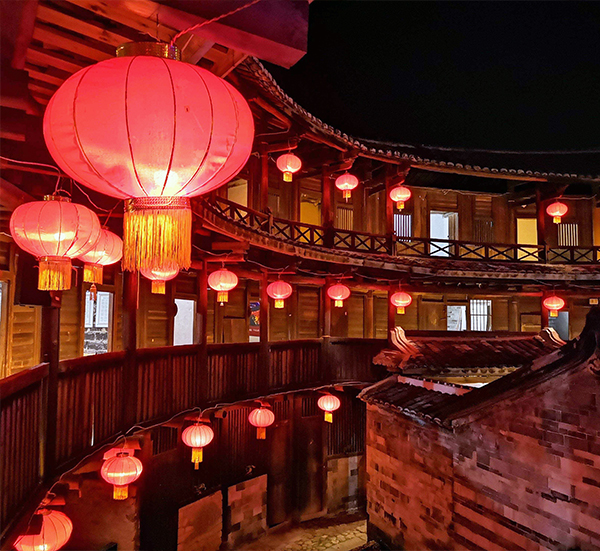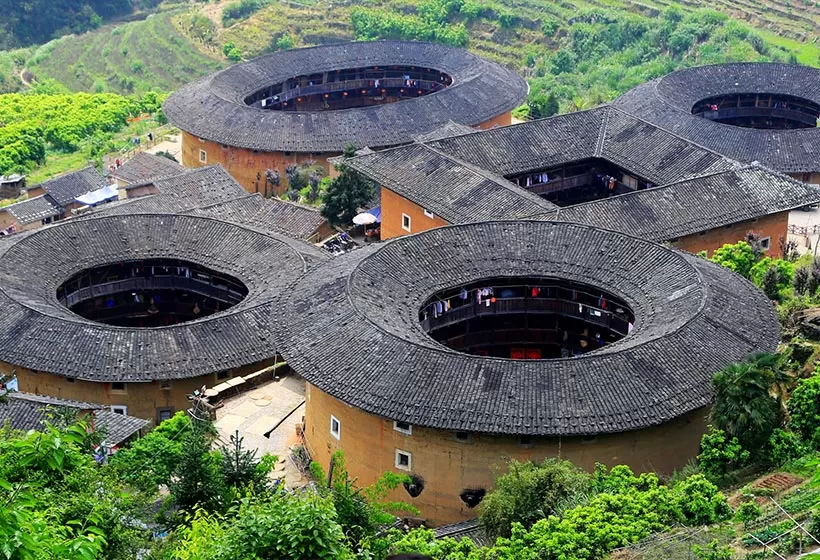Best Places to Visit in Fujian: Xiamen, Fuzhou, Quanzhou
When the emerald waves of the East China Sea kiss the red cliffs of the Wuyi Mountains, and the tides of Meizhou Bay awaken the morning mist around the Hakka Tulou, the cities of Fujian shine like jewels embedded along China’s southeastern coast, each radiating its own unique brilliance. Here lie the legends of the ancient Maritime Silk Road, the elegance of clear waters and crimson peaks, and the majestic symphony of mountains and sea. Following are the best places to visit in Fujian.
Top 1: Xiamen
On the shore of the East China Sea and beside Lu River, the sound of piano music from Gulangyu drifts on the sea breeze, gliding past architecture where East meets West. Looking up, you see a fresh blue sky; looking around, you’re surrounded by pleasant greenery. The sunset, evening glow, and ocean together form a beautiful "garden on the sea"—this is Xiamen.
Xiamen City is located on the southeastern coast of Fujian Province, covering a total area of 1,700.61 square kilometers. It consists of the Xiamen Bay, its adjacent mainland areas, and several islands including Xiamen Island and Gulangyu. Its unique geographic location gives Xiamen a seemingly endless summer, just like the city’s ever-blooming flowers, from the flamboyant phoenix blossoms cascading like waterfalls to the vibrant bougainvillea in full flourish, passionate and captivating.
Xiamen’s fame is so widespread that for many people, it is the first place that comes to mind when they think of Fujian. Here boasts both European-style villas and Chinese traditional red-brick buildings. There’s Gulangyu, known as the “Island of Pianos”, the seaside Xiamen University, as well as Shuzhuang Garden, South Putuo Temple, and Zengcuo’an—all offering unforgettable experiences that keep visitors coming back.
Top 2: Fuzhou
In the southeastern corner of China, bathed in the morning light of the East China Sea, lies an ancient yet vibrant city. Here, mountains, rivers, and the sea converge; here, the rich Min culture was born. Once known as "Rongcheng", today this city is called Fuzhou.
Fuzhou, historically referred to as Mindu, is the capital of Fujian Province. It is located at the eastern end of central Fujian, facing the Taiwan Strait to the east, and spans a total area of 11,968.53 square kilometers. This land is blessed with a harmonious blend of mountains and waters, lush greenery, murmuring streams, and encircling peaks. It is also a fertile ground for culture, producing generations of talent and preserving a cultural legacy that stretches back over a thousand years.
With a city history of more than 2,200 years, Fuzhou has served as the provincial capital since the Ming Dynasty. It embodies the essence of Min culture, with landmarks such as the Tanshishan archaeological site, the Foochow Shipbuilding, the Three Lanes and Seven Alleys, and the Shoushan stone. The city has produced many notable historical figures, including Lin Zexu and Yan Fu. The narrow, timeworn alleys, centuries-old temples filled with incense, and scattered former residences of historical figures all reveal the profound cultural depth of old Fuzhou and the tranquil, understated lifestyle of its people.
Top 3: Quanzhou
When you arrive in this thousand-year-old city, you’ll find that in Quanzhou, known as the “City of Deities”, people move through daily life with faith and passion, where the earthly hustle intertwines with sacred incense smoke endlessly.
Quanzhou, abbreviated as “Li”, is one of Fujian Province’s three major central cities. Located on the southeastern coast of Fujian, it borders Fuzhou to the north, Xiamen to the south, Taiwan across the sea to the east, and Zhangzhou to the west. The city spans an area of 11,295.57 square kilometers.
As a vital hub on the ancient Maritime Silk Road, Quanzhou was already the largest port in the East during the Tang and Song dynasties, rivaling Alexandria in Egypt, where once witnessed the grandeur of flourishing trade and countless merchant ships. Quanzhou is also famed as a “World Museum of Religions”, where diverse religious cultures have long coexisted peacefully. From the twin towers of Kaiyuan Temple reaching into the sky, to the meditative serenity of Qingyuan Mountain, to the red-brick traditional houses lining West Street in the ancient city, Quanzhou has reemerged into public view with renewed vitality and charm.
Top 4: Wuyishan
Wuyi Mountain, a place of breathtaking landscapes, has long been a destination of great longing. The meandering curves of the Jiuqu River alone are enough to captivate visitors and leave them enchanted. The renowned Neo-Confucian scholar Zhu Xi of the Southern Song Dynasty lived, wrote, and taught here for 50 years—Wuyi was the birthplace, cradle, and springboard of Zhuzi Neo-Confucianism. Many historical figures such as Fan Zhongyan, Lu You, and Xin Qiji have also left behind poetry and prose praising Wuyi’s beauty.
Wuyishan City, named after the mountain, is located in the northwest of Fujian Province at the border with Jiangxi, under the administration of Nanping City, with a total area of 2,813 square kilometers.
Wuyi Mountain is famed for its scenic charm, rich history, and vibrant culture, often described as “emerald waters and vermilion peaks”. It is not a towering, rugged mountain, but rather one of gentle grace and mild beauty. Here, mountains and waters merge in harmony, as if shaped by nature’s most artful hand, bringing together the finest elements of landscape. The waters are crystal clear—bamboo rafts glide along the Jiuqu River, carrying visitors as if through a living painting. Whether still and mirror-like or sparkling under the sun, the water reflects the elegant silhouette of the surrounding peaks, making refreshing and pleasant.
Top 5: Zhangzhou
Where mountain winds meet the sea breeze, and ancient charm dances with modern trends, flows the mighty Jiulong River, nurturing the vast plains of Zhangzhou. Its fertile hills and fields have earned it the title "City of Flowers and Fruits", while its deep blue bays open up a boundless vision of the ocean. This is Zhangzhou, where the Daiyun Mountains extend inward and outward, forming a natural protective barrier for the city.
Zhangzhou is located in the southern part of Fujian Province, bordered by Xiamen to the east and adjacent to Guangdong to the west. The region is predominantly mountainous, with beautiful peaks and secluded terrain where Hakka tulou dot the hills. These quiet, unassuming dwellings reflect the peaceful, humble life of the Hakka people. Along the coast lies the Dongshan Island, the second-largest island in Fujian and a dream destination for travelers, where turquoise seas meet golden sands, palm trees sway in the breeze, and breathtaking sunrises and sunsets color a relaxed island lifestyle. On the north bank of the Jiulong River sits Zhangzhou Ancient City, like a weighty tome of history, bearing the stories of time and the rich layers of the past.
Customize Your Eight Min Fujian Tour

If you are interested in the Fujian itineraries mentioned above, please contact us, and we will be happy to customize it and provide a quote tailored to your preferences.
Alternatively, if you would like to customize your Fujian Tour, please visit our Fujian Tour Customized Center. We assure you that you will receive a reply within 24 working hours.
Informative Articles for Your Fujian Trip
 Fujian Tulou
Fujian Tulou- Travel Guide: attractions, weather, culture, etc.
- Weather: best time and seasons to visit Fujian
- Top attractions: sightseeings to watch in Fujian
- Local culture: brief history, folk culture, food, etc.
- Top destinations: best places to visit in Fujian
- Travel itineraries: itineraries for your reference
- Abundant activities: Fujian cultural immersions
- Unique perspective: top interesting things to do
- Local food: what to eat while traveling in Fujian
- Luxury hotels: accommodation to stay in Fujian
- Fujian Tours: customized tours for your reference
GREAT FAMILY CHINA TOUR
JULY 2024 We wanted to thank Grace at China Culture tour for organizing a great tour of China. We enjoyed our Beijing - Xian-Chengdu -Guilin -Yangshuo - Shanghai trip. Our local guides Bruce in Beijing, Susan in Xian, Jane in Chengdu, Mike in Guilin and Mary in Shanghai took care of us…read more details »
Teng Han L from SINGAPORE
Ready to Create a Unique Dream Travel?


